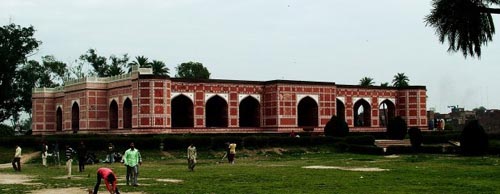Sujauddin Tomb

Information on Sujauddin Tomb (Murshidabad, West Bengal) - History & Architecture
Tomb of Sujauddin is a popular historical place, situated in the array of river Bhagirathi in Murshidabad of West Bengal. It is popularly termed as 'Sujauddin's Mosque' or 'Garden of Joy'. In accordance with the inscription of the tomb, it was created by Nawab Sujauddin during the period of 1727 AD to 1739 AD. It is possibly one of the earliest monuments in Murshidabad.
Sujauddin Tomb Architecture
The construction of Tomb of Sujauddin was based on walled compound which stands around a brick with arched mosque in the northwest side. In the front side, there is a rectangular catacomb of Sujauddin, having a small verandah. Tomb of Sujauddin is a rectangular structure that follows the tradition of Mughal architectural style. Furthermore, the design of the tomb also replicate Dhaka style of construction. Tomb of Sujauddin is covered by three domes, where the largest one is positioned in the center. The center dome is bordered by two smaller domes. It is a semi-circular structure and is capped with lotus design. The ramparts and the cornice of Tomb of Sujauddin is highly ornamented and fragmented into two rows.
There are three arched entrances in the Tomb of Sujauddin that fling the eastern wall. Harmoniously, the western wall of the monument comprise three niched mihrabs. The central entrance is the large entrance of Tomb of Sujauddin, having four-sided projection which is carried up to the stockade. At every direction of the projection, there is an octagonal slim turret which ascends over the walls. There are about four octagonal turrets having chain of bands which are decorated with attractive shell kiosks. Tomb of Sujauddin is enclosed by spherical domes which are attached in the corners of the building. There are three sunken single pointed archways in the mosque which is bordered by curved engrailed arches, a feature which is rarely seen in other mosques of India. It is worth mentioning that the mihrab projection in the western wall of Tomb of Sujauddin which bears 'do-chala' style is first of its kind to appear on any mosque of West Bengal. Thus its unique architectural style makes it a prominent historical structure in Murshidabad district of West Bengal.
Sujauddin Tomb History
Tomb of Sujauddin is an 18th century construction. According to history, apart from Sujauddin, his wife Lutffannesha, his mother Nawab Ali Vardi Khan and other members of Sujauddin's family were also buried in Tomb of Sujauddin. It was said that after demise of Sujauddin, his wife became the concierge of the graveyard. Tomb of Sujauddin contains a well-arranged garden, and similar to other tombs of popular Muslim rulers of India, the tomb of Sujauddin resides at the centre position of the garden. The real gravestone of Sujauddin is pretty unadorned.
The mosque which resides within Tomb of Sujauddin was created by Mahabat Jang in the year 1743 AD. Since he was the ruler during the period of 1740 to 1756, it can be assumed that the mosque has been constructed after four years of demise of Sujauddin.
Sujauddin Tomb Tourism Importance
Tomb of Sujauddin is a great place for tourism. Travellers can enjoy the pleasant view of the monument along with various attractive structures. People who are highly interested in the subject of history and archaeology can find Tomb of Sujauddin quite interesting. Furthermore, Tomb of Sujauddin is also a good place to visit for experience pursuers and for wanderlust people.
- Andaman Nicobar Monuments
- Andhra Pradesh Monuments
- Assam Monuments
- Bihar Monuments
- Chhattisgarh Monuments
- New Delhi Monuments
- Goa Monuments
- Gujarat Monuments
- Haryana Monuments
- Himachal Pradesh Monuments
- Jammu and Kashmir Monuments
- Karnataka Monuments
- Kerala Monuments
- Madhya Pradesh Monuments
- Maharashtra Monuments
- Odisha Monuments
- Punjab Monuments
- Rajasthan Monuments
- Tamil Nadu Monuments
- Telangana Monuments
- Uttar Pradesh Monuments
- West Bengal Monuments